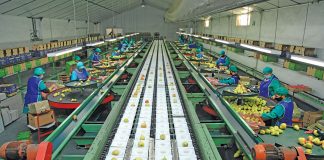
Life often takes strange twists and turns. Even in his wildest imagination, the teenage Ludwig Taschner could never have guessed that a decade after escaping East Germany in 1960 he would be South Africa’s pre-eminent rose grower and breeder.
The business he started among the thorn trees here in early 1971 has grown exponentially and currently produces 500 000 rose plants a year. These are destined for specialised Ludwig’s Roses outlets – in Pretoria, Johannesburg, Durban, Cape Town and Stellenbosch – as well as garden centres across the country.
The company produces approximately 800 rose varieties on the 50ha Ludwig’s Roses farm alongside the N1 North to Polokwane. It is truly a family business: Ludwig is assisted by his wife Pamela, their son Halmar and their daughters Heike and Anja. All live within walking distance of each other on the farm.
Post- war Europe
Ludwig’s horticulturalist parents, Ruprecht and Dietmute, met in Berlin before Ruprecht was conscripted into the German Army in 1939. Ludwig was born three years later as Europe was going up in flames. The family survived the war, however, despite its horrors and the fact that Ruprecht had fought on several fronts, ending up at the Italian Appenine Mountains.
At the close of hostilities the family were reunited at their home in Osterwieck near the Harz Mountain Range. This now fell under Russian control, but Ruprecht was unwilling to leave for West Germany as the border was still porous and he was convinced in any case that communism would not survive. So he stayed and turned to his love for plants.
“He didn’t think it [communism] would last for 40 years,’’ recalls Ludwig. “Everything was destroyed, but they [his parents] had a big garden and they started a nursery.”
As a child, Ludwig was involved in the nursery and by the age of 14, already knew that he wanted to propagate plants for a living. It was then decided that instead of completing formal school, he would pursue an apprenticeship at a nursery that supplied the family with bare-root fruit trees.
“This was where all the budding, grafting, cuttings and that type of work was done. It was specialised and I loved that. It was the foundation,’’ he recalls.
However, the West and its freedom – often expressed through music and fashion – juxtaposed uncomfortably with the increasing state control of life in East Germany. Soon, the teenager was toying with the idea of defection. This was no trivial matter: if he left, there was the very real possibility that he would never see his family again. Nevertheless in 1960, Ludwig made the decision to leave for the West via Berlin.
Carrying little more than his pruning equipment and cash in his boots, he entered the city under the pretext of taking a job at a nursery and then boarded a flight for Hanover, West Germany. The then 18-year-old had chosen his time well: the ease with which he had managed to leave East Berlin would come to an abrupt halt with the construction of the infamous Berlin Wall the following year.
From Western Europe to Pretoria
Ludwig’s first job in West Germany was at a fruit tree nursery along the Rhine River near Bonn. Along with other young workers he became intrigued by the possibility of working in South Africa. Unfortunately, his age did not qualify him for a work permit – 21 was the minimum age. So he took a job at a Swiss Nursery instead, where he came across an advertisement for a rose budder at John Waterer’s, a famous specialist rose nursery, in Berkshire, England.
He applied, was accepted, and hitch-hiked to Britain in 1961 to take on a challenge that would redefine his appreciation for roses. “They had beautiful roses, varieties I had never seen or heard of. The English were crazy about roses,’’ he recalls. “I really liked England and the people – it was a fantastic grounding for me.’’
Making the break
Ludwig still nurtured ideas of immigrating to South Africa, however, and established several contacts in the country. Then, unexpectedly, he received a letter from Buss Nurseries in Pretoria, a business owned by German immigrant, Hermann Buss. The latter assured him that he would be able to organise a work permit. Arrangements were made, and the 20-year-old arrived in Pretoria in 1962.
“From the airport, we drove to the gardens of the Union Building that were dotted with roses and framed by jacarandas… and the blue sky!’’ he recalls. Buss Nurseries, situated at Kameeldrift, was a substantial rose and bedding plant nursery that demanded particular horticulturalist skills because of the differing weather patterns of Europe and Africa. Ludwig settled down to work.

A multitude of rose varieties is available to the public at Ludwig’s Roses, north of Pretoria, which also sports a restaurant and shop.
Just two years later, though, he was on the move again after a family member convinced him to join a cut flower initiative in Tunis, Tunisia. Assured of his position at Buss Nurseries should he ever return, he left for North Africa. Here, political interference and saline water made effective rose production difficult, and after just 10 months, Ludwig resigned to return to South Africa. He first travelled to East Germany, however, to visit his family. (At that stage, East Germany was allowing visitors in.)
Back at Buss Nurseries, Ludwig began taking on an increasing number of managerial responsibilities. But more change was to follow. In 1968, a major client, the Lion Bridge Group, bought the majority share in Buss Nurseries. Ludwig grew to dislike their ‘corporate’ approach to rose production, and became irritated by the group’s unwillingness to allow experimentation with the propagation of roses in containers.
He resigned in 1970 – despite a contractual clause preventing him from growing roses for sale in the then-Transvaal for five years – explored several options, and finally left for travel in Brazil and the US before heading back to Europe to visit his family. He also travelled to see Israel’s developing cut rose industry which targeted Europe as an export market. Ludwig’s heart had now turned back to Pretoria and in the late 1970s, he returned to the bushveld with fewer savings, but much more wisdom. He committed himself to staying in Pretoria and started looking for land.
A unique business
In February 1971, Ludwig bought almost 9ha for an R11 000 property north of Pretoria. Although the property had a little stream running through it and an old Lister pump, it had no electricity or telephone connections. But with the enthusiasm of youth, he started Pretoria’s first garden service and set about experimenting with container-grown roses so as not to bypass his contractual agreements with Lion Bridge.
He began his operations from a corrugated iron shack in the veld filled with lawn mowers, spades and other tools. His approach to securing clients was simple, direct and effective. “We went to gardens that looked as if they needed us and knocked on the door,’’ he recalls. “In no time, we had 70 gardens.’’
Most of Ludwig’s workers came from Buss Nurseries where he had known them well. But it was probably the arrival of ex-employee, Geelboy Mathibela, that created the impetus behind Ludwig’s Roses. “I started the nursery here,’’ Geelboy explains. “I understand roses better now.’’
Ludwig vividly recalls the planting of the first rootstock by Geelboy on 1 August 1971 before pointing out that it had been fortuitously sourced from a De Wildt landowner who allowed him to cut up a field of virus-free and indexed rose rootstock to make cuttings before the sale of his property.
“That was the base of Ludwig’s Roses,’’ he explains.
From the beginning, he propagated roses in containers. Although growing them in a confined space had its challenges, once perfected, container roses became a runaway success, he says. Ludwig could now provide young blooming roses to nurseries throughout the year, and guarantee their growth once transplanted (unlike producers of pruned bare-rooted plants).

A collection of rose products – including rose vinegar and jam – sold at the Spiced Coffee Restaurant at Ludwig’s Roses.
“Suddenly, the garden centres would buy roses every week. It was quite a revolution,’’ he remembers. “When you got them out of the containers to plant, their growth exploded. So at first our logo was The Rose that Grows. We could guarantee our roses.’’
Small wonder that Ludwig’s pioneering techniques would change garden rose production forever.
“It [containerised rose production] has become the norm in South Africa,’’ he says. “And it’s changing all over the world.’’
Breeding exceptional roses
In 1972, Ludwig began with what would become a central pillar of the Ludwig’s Roses franchise – the popularisation of international varieties in South Africa. In fact, he still represents more than 25 breeders from Europe, Australia and New Zealand. “People want new rose varieties every year,’’ he says.
One of his longest relationships has been with Kordes in Germany. He has successfully popularised and marketed approximately 300 Kordes varieties in 40 years with most receiving names that South Africans could appreciate. For example, Esther Geldenhuys, Johannesburg Sun and Germiston Gold are just some of the Kordes varieties that are as popular today as ever.
Ludwig has also bred exceptional hybrid roses. His cross-pollinating and grafting programmes, which his daughter Anja is now also intimately involved in, have produced 30 unique varieties. One of the most recent, Ludwig believes, is a breakthrough in the breeding of the problematic yellow rose that was famously blamed for the introduction of black spot to European roses in the 1700s.
Since then, international breeders have battled to breed a healthy yellow rose with a bloom that does not fade in the sun. It was therefore with particular pride that Ludwig unveiled The Yellow earlier this year – a yellow rose that performs exceptionally well in the blazing African sun.
“They [yellow roses] get more diseases and the colour is not stable; it bleaches out to white. “We [Ludwig’s Roses] now have a rose that is The Yellow,’’ he concludes.
Email Ludwig Taschner at [email protected] or visit the website www.ludwigroses.co.za.
This article was originally published in the 31 July 2015 issue of Farmer’s Weekly.













